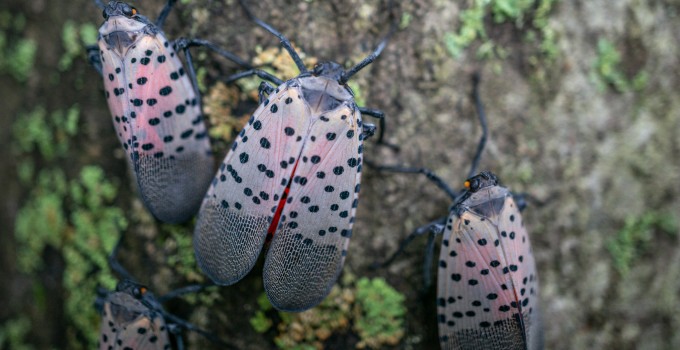How can a little bug that doesn’t sting or bite cause so many problems in Pennsylvania?
By munching on trees, vines, hardwoods, hops, grapes, and other vegetation, the Lycorma delicatula, commonly known as the spotted lanternfly, remains an agricultural threat. The invasive species, native to Vietnam, China, and India, was first spotted in Berks County, Pennsylvania in September 2014 and has been wreaking havoc on lawns and gardens across the state ever since.
What does the spotted lanternfly look like?
The spotted lanterfly gets its nickname from the black spots on its front wings. Its body is red, brown, and black. It measures about one inch in length and half an inch across in adulthood. The pest has six legs and two pairs of wings that give it a butterfly-like appearance when spread.
Despite its wings, the spotted lanternfly can fly only short distances and prefers to walk or jump. It lays between 30 and 50 eggs at a time, usually in the fall. By spring, the eggs hatch into nymphs. By summer, a nymph will have grown into an adult with wings. The full life span lasts around a year.
The spotted lanternfly partner in crime: The Tree of Heaven
The spotted lanternfly likes to make its home on the Ailanthus altissima, also known as the tree of heaven. Like the spotted lanternfly, the tree of heaven is invasive to Pennsylvania and was first brought to the Delaware Valley in the 18th century.
While the spotted lanternfly prefers this tree, it will eat and mate on more than 70 other plant species and lay eggs on nearly any hard surface.
How does the spotted lanternfly hurt plants?
The spotted lanternfly remains the bane of every Pennsylvania gardener. It’s caused so much damage to common crops and vegetation that the PA Department of Agriculture has placed fourteen counties in southeastern Pennsylvania under a quarantine to monitor and study its impact.
The pest uses its piercing mouth to feed on a plant’s sap, which causes weeping sap and mold wounds. These wounds can stunt a plant or even kill it.
To make matters worse, it also secretes sugary water when eating. This sugary water, called honeydew, invites black sooty mold.
Sooty mold is actually a fungal disease that forms on vegetation and other surfaces. It prevents sunlight from reaching plants by coating the leaves’ surface. This makes it more difficult for the plant to perform photosynthesis, stunting its growth and causing premature leaf drop.
What should I do if I discover a possible infestation?
- If you see egg masses, use the edge of a credit card to scrape them into a ziplock bag. Pour rubbing alcohol into the bag to destroy the unborn larvae.
- Squash any spotted lanternfly as soon as you see it.
- Report the sightings to the PA Department of Agriculture at .
- Make sure any garages or sheds have gap-free windows and doors. Frequently inspect their corners and walls.
- If you enter into or out of a quarantined county, check your car and other belongings for eggs before and after travel.
Don’t let the garden or yard you’ve cared for over the seasons get pummeled by this hungry insect. Seitz Bros. can assess the problem and help you protect your outdoor space.

